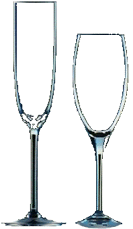
 |
SERVING CHAMPAGNE |
| Madam Lilly
Bollinger: "I drink champagne when I'm happy. And
when I'm sad. Sometimes I drink it when I'm alone. When I have
company I consider it obligatory. I trifle with it if I'm not
hungry and drink it when I am. Otherwise I never touch
it. Unless I'm thirsty." Removing the cork quietly, cooling the wine to right temperature, and to keep it in the bottle or glass and off your guests, is not a natural gift. It requires a little dexterity, concentration, and fortunately, a good dose of practice. Champagne is to be served cold at about 43 to 48 degrees F (7 C). In this range the smell and taste of the wine can be fully appreciated. This temperature can be achieved by placing the unopened bottle in an ice bucket -- one-half ice and one-half water -- for 20 to 30 minutes. Or, you may refrigerate it for 3 to 4 hours. The refrigerator temperature is too cold for the bottle to be left in there for extended periods. It should never be placed in the freezer. The champagne cork is not a toy. There is about 70 pounds-per-square-inch of pressure behind it, thus making it a formidable missile. It helps if the champagne is properly chilled -- at 45 degrees F the gas is reduced one atmosphere of pressure -- and you avoid shaking it as much as possible before opening it. Only remove enough of the foil to be able to loosen or remove the twisted-wire hood. It is wise to keep a finger or thumb over the cork at this point as it could pop out of its own accord. If the cork is loose, remove it carefully with the wire hood. Most often though, the cork has to be eased out. To do this, hold the bottle away from you and anyone else, at a 45 degree angle. It is prudent to place the mouth of the bottle nearest the first champagne glass to be filled in case the removal of the cork is mishandled and the wine begins to gush out of the bottle. Hold the cork and gently turn the bottle in one direction. Turn the bottle and not the cork. The cork should not pop. As the saying goes, "The ear's gain is the palate's loss." You waste bubbles when you pop the cork. When properly executed it should come off with a quiet sigh. Before pouring, the neck should be wiped with a clean linen. Then begin by pouring a little, an inch or so, into everyone's glass allowing the froth to settle. Then go around and top up to about two-thirds. This will prevent any frothing over. The correct way to pour a bottle of champagne is to hold the base firmly in one hand with the thumb in the punt and the fingers spread out along the barrel of the bottle.  Champagne should be served in long-stemmed flutes or tulip shaped glasses. These are designed to enhance the flow of bubbles to the crown and to concentrate the aromas of the wine. Never chill or ice the glass as it would take away from the enjoyment of the wine. Incidentally, since the surface texture of crystal is rougher than ordinary glass, more bubbles form on crystal glasses. Champagne has reached its maturity and is ready for immediate consumption as soon as it leaves the champagne house. However, champagne may be stored in cellar-like conditions for several years. The important conditions are a constant, cool temperature, no vibrations and no light. The bottles must be stored horizontally to keep the cork moist and thus retain its elasticity. This will keep the gas in and the air out. Once opened, a bottle of champagne need not be consumed in one sitting. If properly closed, inexpensive champagne stoppers are made just for this purpose, and it is placed in a refrigerator, it should be good for another "bubbling" for up to several days. The long-stemmed flutes hold approximately 6 oz. when filled to the rim. Therefore, the normal serving is approximately 3 oz. and a .750 ml bottle which holds 25 oz. will provide you approximately 8 servings per bottle. If you are planning a party, this may be a good guideline for your party requirements. Champagne is classified on the label with different levels of dryness or sweetness. The driest is brut (or extra brut), extra dry, ironically, is slightly sweeter, then comes sec, demi-sec and the sweetest category is doux. Demi-sec and doux are very sweet and are considered dessert wines. While serving wedding cake, the brut should be avoided. May 1, 2000 |
Nation Visitors Since March 8, 2013